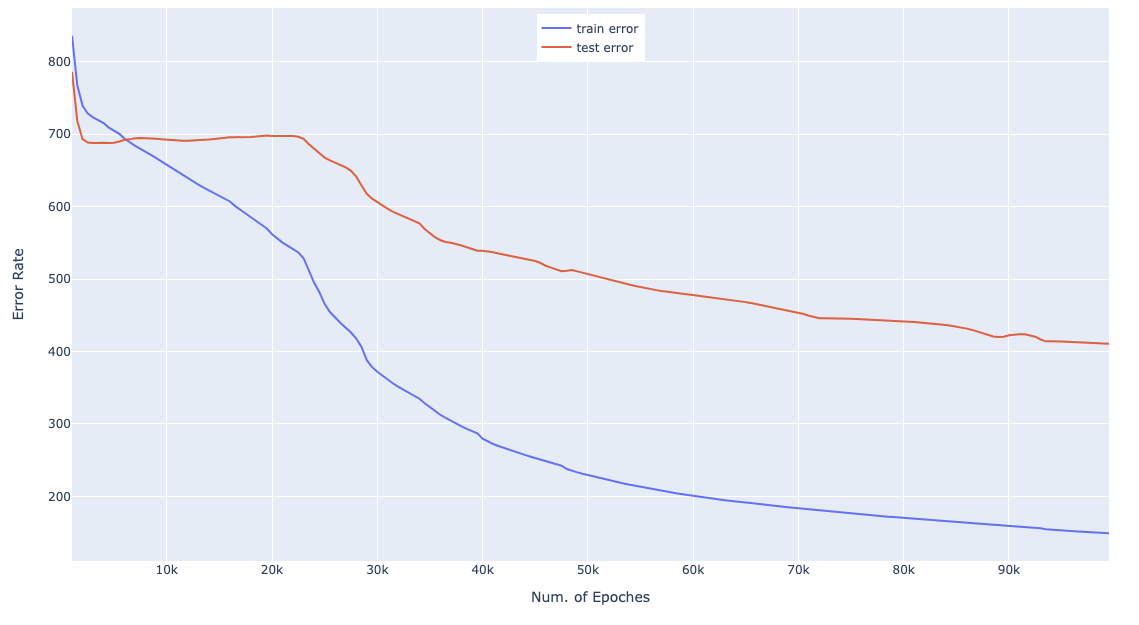import numpy as np
import pandas as pd
import plotly.graph_objects as go
from sklearn.preprocessing import StandardScaler
from sklearn.metrics import mean_squared_error
from sklearn.neural_network import MLPRegressor
def sigmoid(x):
return 1 / (1 + np.exp(-x))
def get_data(size):
mean = [0, 0]
cov = [[1, 0], [0, 1]]
a1 = np.array([3, 3])
a2 = np.array([3, -3])
X = np.random.multivariate_normal(mean, cov, size=size)
Z = np.random.normal(loc=0, scale=1, size=size)
Y = sigmoid(np.dot(a1, X.T)) + np.square(np.dot(a2, X.T)) + 0.3 * Z
Y = Y.T
return [X, Y]
X_train, y_train = get_data(100)
X_test, y_test = get_data(1000)
# scale data
scaler = StandardScaler()
scaler.fit(X_train)
X_train = scaler.transform(X_train)
X_test = scaler.transform(X_test)
# NN regressor
train_epochs = np.arange(1000, 100000, 500)
weight_decay_coefs = [0.001]
hidden_units = np.arange(10, 11)
hidden_unit_list = []
train_error_list = []
test_error_list = []
epoch_list = []
weight_decay_list = []
for weight_decay_coef in weight_decay_coefs:
for train_epoch in train_epochs:
for hidden_unit in hidden_units:
print('alpha is : {}, epoch is {}, hidden unit is {}'.format(
weight_decay_coef, train_epoch, hidden_unit))
regr = MLPRegressor(random_state=1,
hidden_layer_sizes=(hidden_unit,),
max_iter=train_epoch,
alpha=weight_decay_coef,
activation='logistic').fit(X_train, y_train)
y_train_pred = regr.predict(X_train)
y_test_pred = regr.predict(X_test)
train_error = mean_squared_error(y_train, y_train_pred)
test_error = mean_squared_error(y_test, y_test_pred)
hidden_unit_list.append(hidden_unit)
weight_decay_list.append(weight_decay_coef)
epoch_list.append(train_epoch)
train_error_list.append(train_error)
test_error_list.append(test_error)
df = pd.DataFrame({'num. hidden unit': hidden_unit_list,
'num. epoch': epoch_list,
'weight decay': weight_decay_list,
'train error': train_error_list,
'test error': test_error_list})
print(df)
df_tmp = df.loc[df['num. hidden unit'] == 10]
df_tmp = df_tmp[df_tmp['weight decay'] == 0.001]
# Create traces
fig = go.Figure()
fig.add_trace(go.Scatter(x=df_tmp['num. epoch'], y=df_tmp['train error'],
mode='lines',
name='train error'))
fig.add_trace(go.Scatter(x=df_tmp['num. epoch'], y=df_tmp['test error'],
mode='lines',
name='test error'))
fig.update_layout(
xaxis_title="Num. of Epoches",
yaxis_title="Error Rate",
)
fig.update_layout(legend=dict(
yanchor="top",
y=0.99,
xanchor="center",
x=0.5
))
fig.show()
